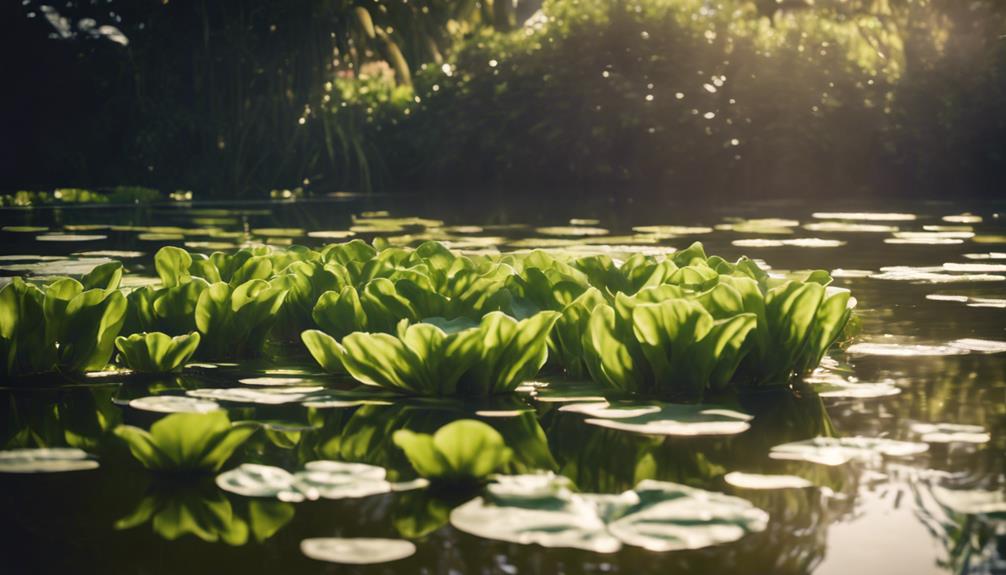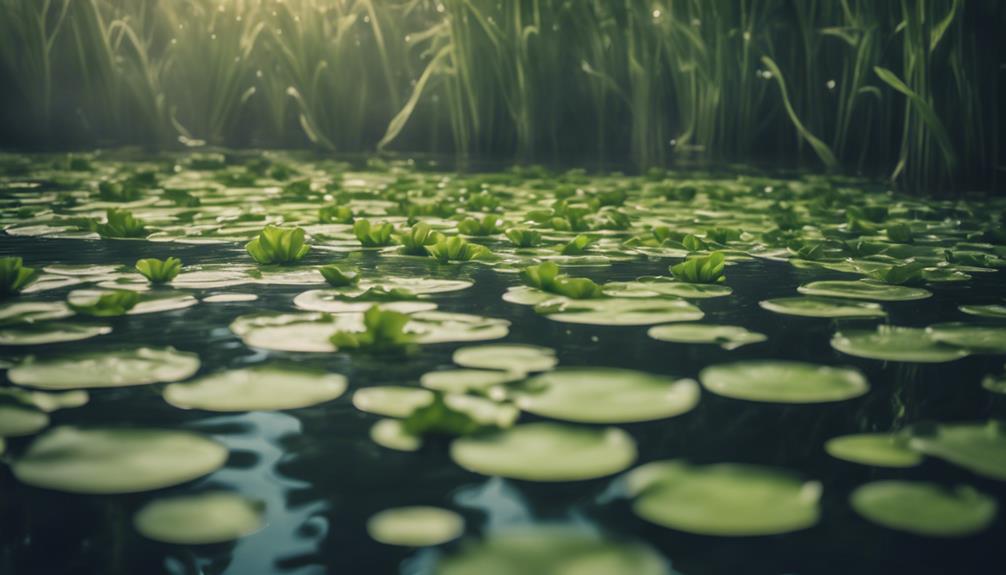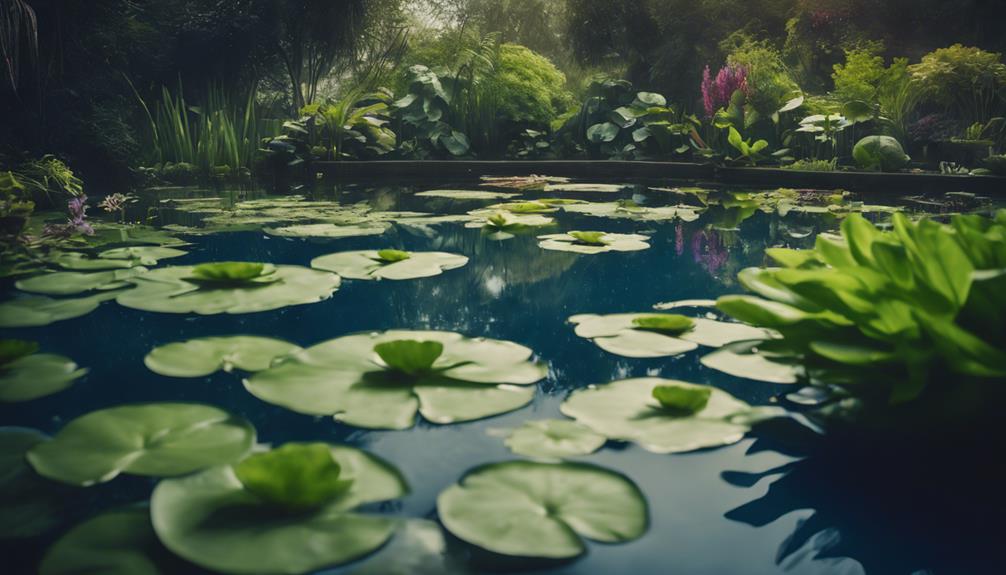When choosing the best floating plants for your garden, consider Water Wisteria Delights for their unique aesthetic appeal and functional benefits, or Floating Lotus Beauty for a serene ambiance. Hydrocotyle Nymphs Abound promote healthy growth and biodiversity, while Water Wisteria thrives in various water conditions. For shade, opt for Water Hyacinth, Frogbit, or Azolla Fairy Moss. To support local wildlife, incorporate plants like Water Hyacinth, Water Lettuce, and Duckweed. By selecting the right floating plants, you'll create a thriving ecosystem. Now, explore the world of floating plants to discover the perfect balance for your garden.
Table of Contents
Key Takeaways
- Water Wisteria Delights and Floating Lotus Beauty are popular floating plant options that offer aesthetic appeal and functional benefits.
- Floating Fern, Water Hyacinth, and Water Lettuce are free-floating species that help reduce algae growth and absorb excess nutrients.
- Water Hyacinth, Frogbit, and Azolla Fairy Moss provide up to 90% shade, reducing algae growth and creating a habitat for aquatic life.
- Hardy floating plants like Duckweed and Azolla can thrive in varying water temperatures, making them ideal for creating a wildlife habitat.
- Low-maintenance options like Water Lettuce, Duckweed, and Azolla Fairy Moss are perfect for beginners and experienced gardeners alike.
Benefits of Floating Plants
By incorporating floating plants into your garden, you can experience a range of benefits that enhance both its aesthetic appeal and ecological health.
One of the most significant advantages of floating plants is their ability to purify the water. As they grow, they absorb excess nutrients and pollutants, creating a healthier environment for aquatic life. This, in turn, supports a balanced ecosystem, which is essential for a thriving garden.
Floating plants also promote healthy growth by providing shade, reducing algae growth, and regulating water temperature. This creates an ideal environment for other plants to flourish, resulting in a lush and vibrant garden.
Additionally, floating plants help to reduce evaporation, conserving water and minimizing the need for frequent watering. By incorporating these plants into your garden, you can create a sustainable and eco-friendly space that not only looks beautiful but also supports the local wildlife.
With their numerous benefits, it's no wonder why floating plants are becoming increasingly popular among gardeners.
Top Floating Plant Options
As you explore the world of floating plants, you'll want to weigh the top options that can elevate your garden's aesthetic and functionality.
You'll find that Water Wisteria Delights, Floating Lotus Beauty, and Hydrocotyle Nymphs Abound are popular choices among gardeners, each offering unique benefits and characteristics.
Water Wisteria Delights
When it comes to selecting the best floating plants for your garden, Water Wisteria stands out as a top option, offering a unique combination of aesthetic appeal and functional benefits.
As a popular floating plant, Water Wisteria (Hygrophila difformis) can thrive in a wide range of water conditions, making it easy to care for. Its delicate, lacy leaves are a beautiful shade of green and can grow up to 10 inches in length, adding a stunning touch to your water garden.
Not only does Water Wisteria enhance the visual appeal of your garden, but it also provides functional benefits.
As a fast-growing plant, it can help keep the water clean by absorbing excess nutrients and producing oxygen, making it a natural water purifier. Additionally, it provides a habitat for small aquatic animals, such as fish and shrimp, offering them shelter and food.
With its hardiness and ability to survive in temperatures ranging from 65-85°F, Water Wisteria is an ideal choice for both indoor and outdoor water gardens, ensuring you can enjoy its benefits in any setting.
Floating Lotus Beauty
Among the top floating plant options, Floating Lotus Beauty stands out for its elegant, cup-shaped blooms and ability to provide a serene, tranquil ambiance to your water garden.
This stunning floating pond plant is sure to captivate your senses with its majestic appearance and calming presence. As you gaze upon its delicate petals, you'll appreciate the aesthetic appeal it brings to your water surface.
Not only does it add visual beauty, but it also helps to create a sense of calm and serenity, making it an ideal choice for those seeking a peaceful retreat.
With its ability to thrive in a variety of water conditions, Floating Lotus Beauty is a low-maintenance option that's perfect for beginners and experienced gardeners alike.
By incorporating this floating plant into your garden, you'll be rewarded with a truly breathtaking display that will leave you feeling connected to nature.
Hydrocotyle Nymphs Abound
You can enhance the beauty and biodiversity of your water garden with Hydrocotyle Nymphs Abound, a top floating plant option that offers a range of benefits and aesthetic appeal.
As a popular choice among gardeners, Hydrocotyle Leucocephala is an affordable option, priced at $9, making it accessible to many.
This floating plant promotes healthy growth of floating plants, creating a thriving ecosystem in your pond.
One of the unique features of Hydrocotyle Nymphs Abound is its ability to provide hiding places for fish, adding an extra layer of complexity to your water garden.
Additionally, its delicate foliage adds texture and visual interest to the surface of the water.
With its ability to thrive in a variety of conditions, Hydrocotyle Nymphs Abound is an excellent choice for gardeners of all skill levels.
Easy Maintenance Tips

As you bring floating plants into your garden, you'll want to guarantee their health and longevity by following some easy maintenance tips.
First, you'll need to establish a watering schedule that meets their unique needs, taking into account factors like climate and water quality.
Watering Schedule Essentials
Maintaining a consistent watering schedule is crucial for the health and survival of your floating plants, so establishing a routine that works for you and your aquatic environment is paramount.
You'll want to provide the right amount of water, as over-watering can be detrimental to your plants.
Monitor water levels: Regularly check the water level in your pond or aquarium and top it up as needed to guarantee your floating plants receive the necessary amount of water and nutrients.
Check water parameters: Regularly test the water temperature, pH, and nutrient levels to confirm they're within the suitable range for your floating plants.
Avoid over-watering: Don't add too much water, as this can lead to root rot and other problems. Instead, focus on maintaining a consistent water level.
Remove excess growth: Regularly remove excess growth and debris from the pond or aquarium to maintain a healthy environment for your floating plants and prevent the buildup of toxins.
Plant Health Checks
Regular plant health checks are essential for detecting early signs of distress, allowing for prompt intervention and prevention of widespread damage.
As you care for your floating plants, you'll want to regularly inspect their leaves, stems, and roots for any signs of trouble. Check for yellowing or browning leaves, soft spots, or unusual odors, which can indicate nutrient deficiencies or pest infestations.
Make sure your plants are absorbing nutrients properly by monitoring their growth rate and color. A healthy plant should have vibrant green leaves and sturdy stems.
During your checks, also inspect the water quality and adjust it as needed. Verify the water is clean, clear, and at the right temperature for your plants.
You can use water testing kits to monitor pH levels, ammonia, and nitrite levels. By catching any issues early, you can take corrective action to prevent the problem from spreading.
This proactive approach will help maintain peak plant health, allowing your floating plants to thrive and continue to absorb nutrients efficiently.
Popular Free-Floating Species
When it comes to adding visual interest and improving water quality, incorporating popular free-floating species into your garden or pond can be a great option.
These plants are easy to care for and can thrive in a variety of water conditions.
Floating Fern (Salvinia natans): This tiny fern forms a mat of pinnate leaves and can help reduce algae growth by blocking sunlight and absorbing excess nutrients.
Water Hyacinth: With its beautiful violet blooms and ability to grow up to 26 inches in height, this popular free-floating species is a great option for adding color and texture to your garden or pond.
Water Lettuce (Pistia stratiotes): This free-floating perennial forms small rosettes and can be used as a natural filter to remove excess nutrients from the water.
American Frogbit (Limnobium spongia): This floating perennial forms loose rosettes of rounded leaves and can provide shelter for fish and other aquatic animals.
Floating Plants for Shade

You can create a shaded oasis in your pond or garden by incorporating floating plants that not only provide shelter from the sun but also offer additional benefits such as improved water quality and habitat creation.
When it comes to providing shade, some plants grow best in shaded areas, and floating plants are no exception.
Water Hyacinth, for instance, can spread across the water's surface, providing up to 90% shade.
Frogbit, on the other hand, creates a dense mat on the water's surface, blocking out sunlight and reducing algae growth.
Azolla Fairy Moss not only provides shade but also fixes nitrogen, making it ideal for gardens with poor soil quality.
Salvinia Natans is another fast-growing option that removes excess nutrients from the water, while Duckweed provides shade and serves as a food source for fish and other aquatic animals.
Wildlife Habitat Creation
By incorporating floating plants into your garden or pond, you're not only creating a shaded oasis, but also opening up a world of possibilities for wildlife habitat creation, as these plants provide essential shelter, food, and breeding grounds for a diverse range of aquatic animals and insects.
Floating plants can support wildlife in your pond in several ways.
Hiding places: Plants like Water Hyacinth and Water Lettuce provide hiding places for baby fish, shelter for aquatic insects, and a haven for amphibians.
The roots of floating plants like Frogbit and Sensitive Plant absorb nutrients from the water, making them unavailable to algae and supporting a balanced ecosystem.
Hardy floating plants like Duckweed and Azolla can thrive in temperatures as low as 59-60°F, making them ideal for creating a wildlife habitat in gardens with varying water temperatures.
The leaves of floating plants like Mosaic Flower and Red Star Ludwigia provide a food source for herbivorous fish and other aquatic animals, supporting the food chain and promoting biodiversity in your garden.
Water Quality Improvement

Floating plants play a crucial role in maintaining excellent water quality in your pond or garden by absorbing excess nutrients, reducing algae growth, and oxygenating the water.
As you incorporate these plants into your garden, you'll notice a significant improvement in the overall health of your water ecosystem.
By absorbing excess nutrients, floating plants prevent algae from growing out of control, which can lead to a decrease in oxygen levels and an increase in water toxicity.
This, in turn, creates a healthier environment for aquatic life to thrive.
As the plants grow, they'll also help to stabilize the water's pH levels, reducing the risk of sudden changes that can be detrimental to your aquatic life.
By choosing the right floating plants for your garden, you'll be able to enjoy crystal-clear water that's teeming with life.
With proper care and maintenance, your floating plants will continue to grow and flourish, providing you with a beautiful and thriving water feature that you'll love to spend time around.
Choosing the Right Floating Plants
Selecting the right floating plants for your garden requires careful consideration of key factors, including water temperature, pH, and lighting conditions, to guarantee the plants thrive and provide maximum benefits to your water ecosystem.
When choosing the perfect floating plants for your garden, remember to consider the following:
- Consider the mature size of the plants and the space available in your garden to prevent overcrowding and promote proper growth.
- Research the hardiness zones and invasive species status of floating plants before introducing them to your garden to prevent ecological damage.
- Choose plants with different growth rates and textures to create a visually appealing and diverse ecosystem, providing hiding places for aquatic life and beauty on the water's surface.
- Select low-maintenance plants like Water Lettuce, Duckweed, and Azolla Fairy Moss, which are perfect for beginners and can flourish in your water garden.
Floating Plant Care Essentials

You'll need to provide regular maintenance to keep your floating plants thriving, as neglecting their care can lead to overcrowding, reduced water quality, and even harm to aquatic life.
First, monitor the growth of your floating plants and remove any excess growth to prevent overcrowding and maintain water quality. Regular fertilization is also necessary to keep your floating plants healthy and thriving. You can use fertilizers like Pondtabbs – Fertilizer Tablets to provide essential nutrients.
When adding floating plants to your water garden, make sure to do so in the spring when temperatures have warmed up, and the pond water is above 65 degrees. This is especially important for plants like Water Hyacinth and Water Lettuce, which grow best in water temperatures above 65°F.
Regularly net out your floating plants to prevent overcrowding and reduce the risk of oxygen reduction and fish kill. Remove excess plants and dispose of them properly to prevent invasive species from spreading to natural bodies of water. By following these care essentials, you'll create a thriving water garden with plenty of hiding places for your aquatic friends.
Frequently Asked Questions
Do Floating Plants Spread?
You'll find that floating plants can indeed spread rapidly, potentially becoming invasive species that impact water quality by altering plant density, so it's essential to monitor and maintain their growth to prevent ecological imbalance.
What Are the Three Floating Plants?
"As you step into your serene water oasis, you'll discover three floating plants that'll transport you to a bygone era: Water Hyacinth, Water Lettuce, and Frogbit, each boasting unique aesthetic variations, growth patterns, and environmental impact that'll make your garden thrive."
Do Floating Plants Need Soil?
You're wondering if floating plants need soil? Well, they don't! In soilless cultivation, their roots aren't root-bound, and they absorb water nutrition directly, making soil unnecessary.
Do Floating Plants Oxygenate the Water?
You'll be amazed to discover that, yes, floating plants do oxygenate the water, remarkably improving water clarity, supporting thriving aquatic life, and boosting oxygen levels, creating a balanced ecosystem you'll feel proud to belong to!
Conclusion
As you wade into the world of floating plants, remember: 'A rolling stone gathers no moss,' but a well-chosen floating plant can bring liveliness to your garden's water features!
With the right selection, you'll create a thriving ecosystem that supports local wildlife, improves water quality, and adds visual appeal.
By following the maintenance tips and choosing the best floating plants for your space, you'll be well on your way to a stunning, low-fuss aquatic oasis.

